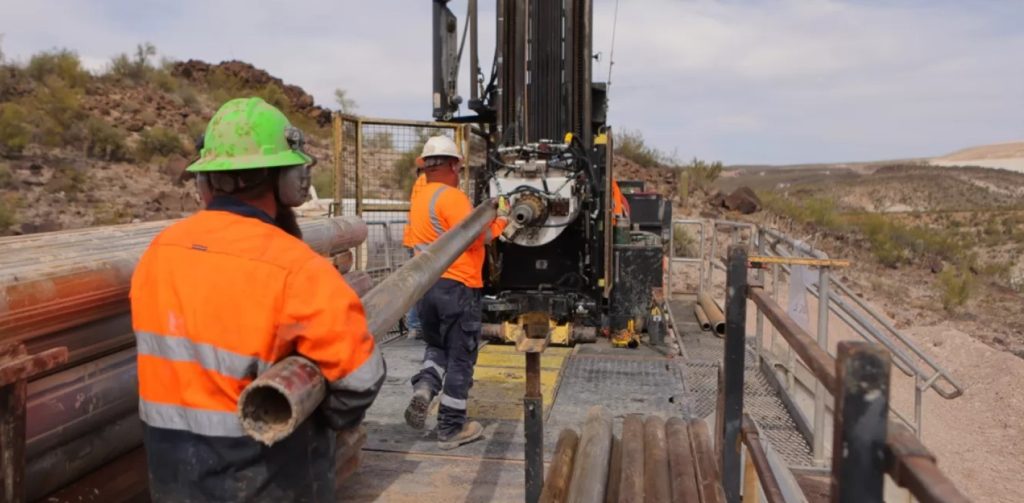Bradda Head Lithium drills 1.27% Li2O 7.28 metres at San Domingo, Arizona

Bradda Head Lithium Ltd. [TSXV-BHL.L; OTC-BHLIF; AIM-BHL] reported final results from core drilling at the San Domingo Central target area, Arizona, completed on December 2, 2023. This is the second of three sets of assays to be released from the company’s 18,950-foot (5,776-metre) program and include very encouraging results across all the target pegmatites.
Results from the San Domingo Central target area are highlighted by the following intervals: 7.28 metres at 1.27% Li2O in hole SD-DH23-069 from 27.43m depth at White Ridge; 5.18m of 0.88% Li2O in hole SD-DH23-072 at White Ridge; 5.06m at 0.49% Li2O in hole SD-DH23-083 at Joker; 2.17m at 0.58% Li2O with 92ppm Sn at Jumbo; 26.52m at 0.27% BeO with 4.44m at 0.40% BeO and 0.02% Li2O in hole SD-DH23-075 at White Ridge.
Jumbo drill hole SD-DH23-037 encountered 9.54m at 1.85% Li2O from 46.24m, highlighting the high grades and shallow nature of lithium mineralization in a hole that is 400m away to the southwest of hole SD-DH23-069.
Summary: Shallow lithium mineralized intercepts were encountered at the Central Target Area, with 90% of significant intercepts at <100m depth.
The pegmatites at White Ridge host 7.28m of 1.27% Li2O, starting at 27.43m in hole SD-DH23-069. In a parallel pegmatite, hole SD-DH23-072 intersected 5.18m of 0.88% Li2O at 23.77m.
Spodumene observed as the dominant lithium mineral with minor amounts of lepidolite.
Coarser spodumene (>20cm, and dominant at San Domingo) has better preservation than finer grained (1-3cm) spodumene, thus, crystal size is important to overall lithium content and simple low-cost recovery methods.
Elements such as tin, tantalum (Ta2O5) and beryllium (BeO) are found to be highly anomalous in the Central Target Area, including 0.40% BeO with 118 ppm Ta2O5 over 4.44m in SD-DH23-075 over 4.44m and within 26.52m at 0.27% BeO.
Tantalum, tin, beryllium, rubidium, caesium, and niobium were consistently found to be strongly anomalous within, or peripheral to, our best lithium intercepts, providing excellent pathfinders for targeting, interpretation, and guides to this ‘Kathleen Valley’ LCT-style of lithium deposit.
These, and prior near surface drill hole intercepts in the Central Target Area, offer potential opportunity for open-pit development when further drilling proves up minable resources. The shallow nature of mineralization is a compelling argument for continued exploration.
Ian Stalker, Executive Chairman, commented: “These results support our view of a near surface potential spodumene lithium resource in the Central section of our San Domingo (SD) property. The results complement and add to the previous reported results in the same area. We have known spodumene mineralization at both Midnight Owl in the north of our SD property and have now added additional near surface intercepts in the Central section.
“Our team has been working diligently throughout the year to interpret the data, and the arrival of the results in December was something of a Christmas present to ourselves! We are also confident that they will be a springboard to the next program. We are encouraged by this second phase of exploration drilling, continue to be excited for the future at SD, and look forward to the next and final set of results from this drilling program.
“It also needs to be noted that the nature of the mineralization encountered to date is simple and shallow; no deep drilling as been undertaken, although this will be considered at a later stage of our Company’s development. Deeper drilling may indeed reveal less mobilisation of the lithium due to weathering and, as a result, broader zones of mineralization.”
This exploration campaign was designed to test for shallow lithium mineralization on targets proximal to existing roads and access, to maximize our ability to test as many pegmatites as possible from the same or proximal drill platforms, keeping disturbance to a minimum.
The final news release, to include results from Morning Star, will follow as soon as data finalization, compilation, and interpretation is completed. Morning Star is approximately 1km to the southwest of Jumbo, along the prominent NE-SW corridor of pegmatites seen on the 10.5km long San Domingo district trend.
Bradda Head Lithium has interests in a variety of projects, the most advanced of which are in Central and Western Arizona: The Basin Project (Basin East Project, and the Basin West Project) and the Wikieup Project.
The Basin East Project has an Indicated Mineral Resource of 17 Mt at an average grade of 940 ppm Li and 3.4% K for a total of 85 kt LCE and an Inferred Mineral Resource of 210 Mt averaging 900 ppm Li and 2.8% K (potassium) for a total of 1.09 Mt LCE. In the rest of the Basin Project SRK has determined an Exploration Target of 250 to 830 Mt of material grading between 750 to 900 ppm Li, which is equivalent to a range of between 1 to 4 Mt contained LCE. All of Bradda Head’s licences are held on a 100% equity basis and are in close proximity to infrastructure.
